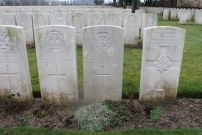| First Name: | George Thomas | Last Name: | EADE | |
|---|---|---|---|---|
| Date of Death: | 14/04/1917 | Lived/Born In: | Blackheath | |
| Rank: | Private | Unit: | Essex2 | |
| Memorial Site: | ||||
Current Information:Age-40 Born-Southborough, Kent Enlisted-Woolwich Aubigny Communal Cemetery, France
The Battle of Arras was a series of offensives by the British Army between 9th April 1917 and 16th May 1917. It had been planned in conjunction with the French who would attack in Artois and between them the Allies would force the Germans out of the large salient they had held since the line of trenches was first established. But the Germans had spoiled this plan by falling back to the new and very strong Hindenburg Line in January 1917 and the salient no longer existed. For the want of an alternative plan the attack went ahead anyway. It all started well for the British who made substantial gains on the first two days but then the offensive ground to a halt and by the end their losses amounted to over 150,000. The First Battle of the Scarpe (9-14 April) On 9th April 1917, 4th Division attacked the German line between Fampoux and Gavrelle. Other divisions had made the initial assault and it was the task of 4th Division to pass through them and attack the 4th German trench system. By the afternoon, 9th Division had done their job. The Black line had been captured as had the Blue line fell, during which the village of Athies was reduced to rubble. Then, at 3.15pm, 12 Brigade, in the shape of 1st Royal Lancaster, 2nd Lancashire Fusiliers and 2nd Essex, passed through to continue the attack. The Oppy-Mericourt line soon fell to them as did the village of Fampoux but their efforts to capture their final objective, the Green line, which lay 500 yards further on were not successful. They could make no progress in the face of heavy machine-gun fire from the railway embankment to the south-east and they dug in along the line of the Fampoux-Gavrelle road, having made a considerable advance. Over the next two days, and in conjunction with the cavalry, the attack was resumed with Greenland Hill as one of the objectives but a combination of snow, rain, freezing conditions and stiff resistance from the enemy doomed this to failure. 2nd Essex were in divisional reserve and sent up individual companies to bolster these efforts and fill gaps as they occurred but were unable to alter the situation and on 13th April the battalion moved back to positions around St Nicolas. Among their casualties during this action was George Eade who died from wounds (gas poisoning) on 14th April. |
||||
| « Back to Search Results | ||||
| If you think any of the information shown here is incorrect, Click Here to submit your amends and comments | ||||




